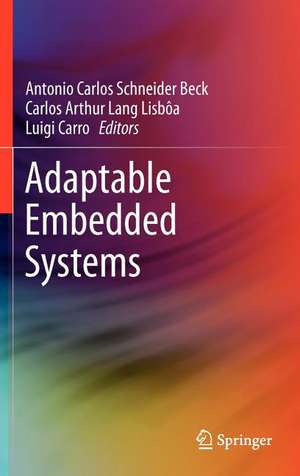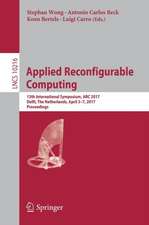Adaptable Embedded Systems
Editat de Antonio Carlos Schneider Beck, Carlos Arthur Lang Lisbôa, Luigi Carroen Limba Engleză Hardback – 21 noi 2012
| Toate formatele și edițiile | Preț | Express |
|---|---|---|
| Paperback (1) | 782.57 lei 6-8 săpt. | |
| Springer – 13 dec 2014 | 782.57 lei 6-8 săpt. | |
| Hardback (1) | 648.24 lei 6-8 săpt. | |
| Springer – 21 noi 2012 | 648.24 lei 6-8 săpt. |
Preț: 648.24 lei
Preț vechi: 762.64 lei
-15% Nou
Puncte Express: 972
Preț estimativ în valută:
124.03€ • 129.52$ • 102.43£
124.03€ • 129.52$ • 102.43£
Carte tipărită la comandă
Livrare economică 15-29 aprilie
Preluare comenzi: 021 569.72.76
Specificații
ISBN-13: 9781461417453
ISBN-10: 1461417457
Pagini: 328
Ilustrații: XIV, 314 p.
Dimensiuni: 155 x 235 x 23 mm
Greutate: 0.64 kg
Ediția:2012
Editura: Springer
Colecția Springer
Locul publicării:New York, NY, United States
ISBN-10: 1461417457
Pagini: 328
Ilustrații: XIV, 314 p.
Dimensiuni: 155 x 235 x 23 mm
Greutate: 0.64 kg
Ediția:2012
Editura: Springer
Colecția Springer
Locul publicării:New York, NY, United States
Public țintă
ResearchCuprins
Adaptability: The Key for Future Embedded Systems.- Heterogeneous Behavior of Applications and Systems.- Reconfigurable Systems.- Reconfigurable Memories.- Reconfigurable Intercommunication Infrastructure - NoCs.- Dynamic Optimization Techniques.- Fault Tolerance.- Multicore Platforms: Processors, Communication, and Memories.- Adaptive Software.- Conclusions.
Textul de pe ultima copertă
As embedded systems become more complex, designers face a number of challenges at different levels: they need to boost performance, while keeping energy consumption as low as possible, they need to reuse existent software code, and at the same time they need to take advantage of the extra logic available in the chip, represented by multiple processors working together. This book describes several strategies to achieve such different and interrelated goals, by the use of adaptability. Coverage includes reconfigurable systems, dynamic optimization techniques such as binary translation and trace reuse, new memory architectures including homogeneous and heterogeneous multiprocessor systems, communication issues and NOCs, fault tolerance against fabrication defects and soft errors, and finally, how one can combine several of these techniques together to achieve higher levels of performance and adaptability. The discussion also includes how to employ specialized software to improve this new adaptive system, and how this new kind of software must be designed and programmed.
- Describes several approaches to adaptability that are applied to embedded systems, such as reconfigurable architectures, dynamic optimization and fault tolerant techniques, multiprocessing systems, SOCs and NOCs;
- Explains how to apply various techniques together to achieve different levels of adaptability, given different application behavior in both hardware and software, highlighting the importance of an adaptable mechanism to accelerate heterogeneous code;
- Offers realistic examples throughout to demonstrate various techniques presented.
Caracteristici
Describes several approaches to adaptability that are applied to embedded systems, such as reconfigurable architectures, dynamic optimization and fault tolerant techniques, multiprocessing systems, SOCs and NOCs Explains how to apply various techniques together to achieve different levels of adaptability, given different application behavior in both hardware and software, highlighting the importance of an adaptable mechanism to accelerate heterogeneous code Offers realistic examples throughout to demonstrate various techniques presented

























